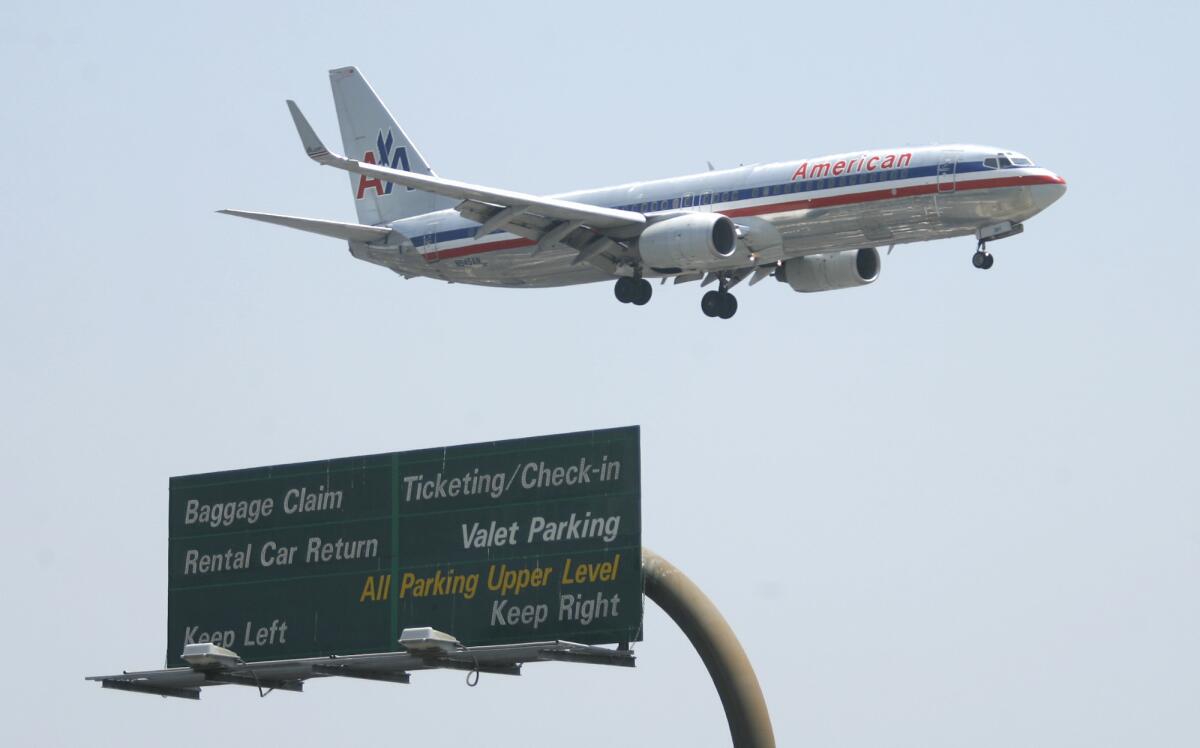Would curving JWA’s takeoff paths across Newport Bay reduce noise? City will help study data

Newport Beach’s city manager plans to work with John Wayne Airport staff and the Federal Aviation Administration to analyze whether changing the airport’s flight departure pattern to match the contours of Newport Bay could result in less noise for more residents.
Newport Beach’s city manager plans to work with John Wayne Airport staff and the Federal Aviation Administration during the next few months to analyze whether changing the airport’s flight departure pattern to match the contours of Newport Bay could result in less noise for more residents.
The City Council gave Dave Kiff approval Tuesday to move forward with airport and FAA officials. The decision comes as the FAA is floating a proposal to narrow flight paths at 11 Southern California airports, including John Wayne, which sits on unincorporated land adjacent to Newport Beach, Irvine and Santa Ana.
The possible change is part of the FAA’s efforts to replace traditional ground-based air traffic procedures with satellite-based technology at those airports.
The agency believes the Next Generation Air Transportation System could save fuel, reduce emissions and delays and shorten flight times by establishing flight plans that are less dispersed than they have been. The FAA plans to roll out NextGen at John Wayne Airport within a year.
The effort has ignited conversation among the Newport Beach Aviation Committee and some community members who are concerned that airplane noise over their homes, which has been an issue for decades in areas such as Newport Heights, Balboa Island and Peninsula Point, could become worse.
Most of the planes departing John Wayne Airport follow a route that takes them across Upper Newport Bay before bisecting Balboa Island and the end of the Balboa Peninsula and turning around a few miles over the ocean.
Under the current system, the pilot has more control of the takeoff route. Under the new system, a precise takeoff path can be programmed into the plane’s flight plan, which could further concentrate flights over residential areas. Residents fear that could increase pollution and noise.
“The NextGen system using GPS has increased the accuracy of the departures to keep planes in their exact lane,” the Balboa Island Improvement Assn. wrote in a letter to the FAA last year. “This technology may actually be increasing the negative environmental impacts on those directly under the departure pattern.”
Though Newport Beach officials have previously advocated keeping existing flight patterns, the council’s action Tuesday allows Kiff to suggest that the FAA consider allowing pilots to use navigation technology to create precisely engineered paths consisting of a series of curves across the center of Newport Bay from the end of the runway to open water.
“Having more curves in the Upper Bay departure paths might keep more planes further from homes on each side of the bay and may further reduce noise impacts,” Kiff wrote in a staff report.
Kiff said the curved departure path also might help reduce the frequency of airplanes flying over specific neighborhoods like Ruby Avenue on Balboa Island, where residents say they see planes a few minutes apart at peak travel times.
Members of the Balboa Island Improvement Assn. expressed support for such a plan, which was first outlined in a 2012 city-commissioned study.
“We’re very pleased the city is moving forward with this plan and taking action on this issue,” said Lee Pearl, the association president. “They took a positive step.”
Decades ago, the city, John Wayne Airport, Orange County and two community groups entered an agreement that established a flight curfew and limits on noise and the number of passengers and departures. The noise-abatement agreement stemmed in part from residents’ complaints. In 2014, the parties extended the agreement through December 2030.
As part of the pact, the county established seven noise monitors along the airport’s departure corridor. For years, air carriers used noise-abatement procedures during departures, such as ascending rapidly and “throttling back” the engines when flying over homes. More recently, planes have technology that reduces the sound of the engines, and many airlines no longer need to use the abatement measures to meet sound requirements.
Kiff plans to work with the airport and the FAA to determine how the altitude of planes departing from John Wayne has changed over the years.
Planes that depart from JWA currently use what’s known as a close-in noise-abatement procedure, in which the pilot initiates a thrust cutback at 800 feet or higher and then retracts flaps — which give planes a slower stalling speed, allowing them to take off on a shorter runway — and slats, which allow planes to fly at slower speeds.
Kiff plans to study whether a distant noise-abatement departure, in which the pilot retracts the flaps and slats before the thrust cutback at around 1,500 feet in the air, would be quieter for more residents than the current procedure.
Still, Kiff cautioned residents and city leaders against getting their hopes up about influencing the FAA’s decision making.
“The FAA doesn’t have to listen to us,” Kiff said. “It could die on the vine, but they have been willing to listen to communities, including ours, in the past.”
